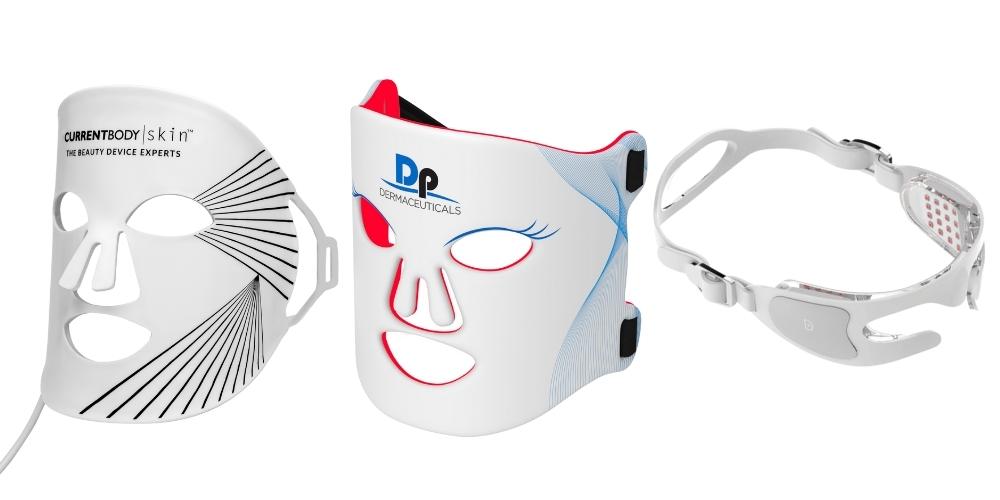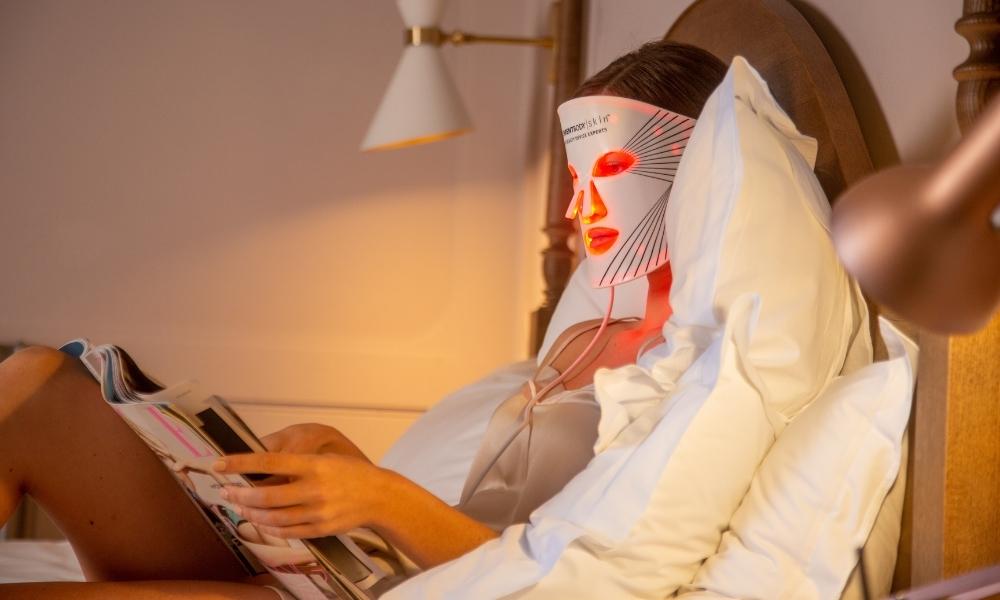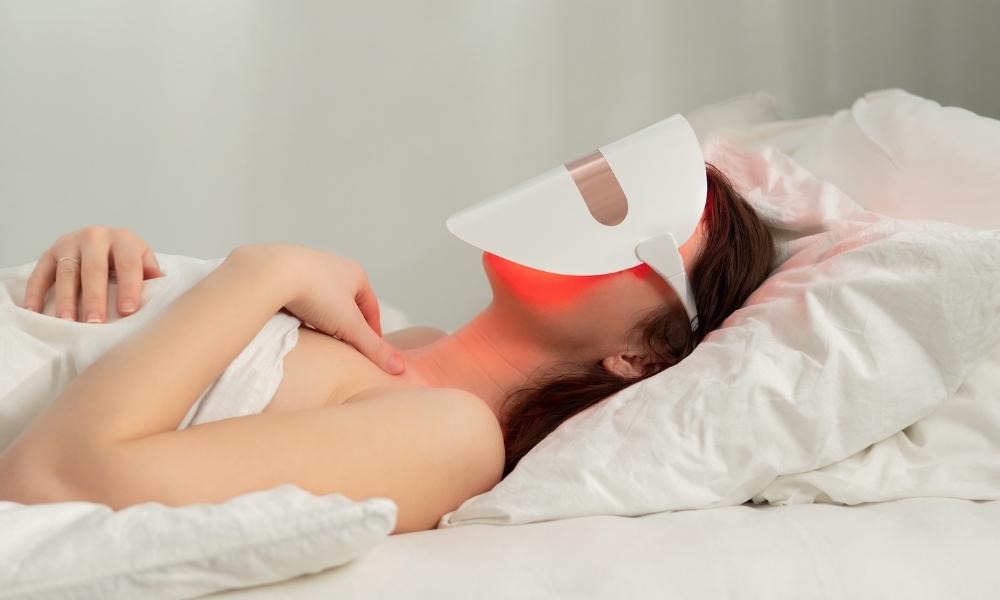If you’ve ever seen someone looking slightly robot-like with a glowing red mask latched onto their face on social media, you’ll have come across LED light therapy. In a skin clinic or salon, it more often looks like a large bank of bright lights placed near your face for a few minutes, often as an ‘add-on treatment’ following another facial or aesthetic treatment.
LED, or light-emitting diode therapy, is a skincare treatment that uses varying wavelengths of light with the aim of helping improve the health and appearance of your skin. Different wavelengths of the visible light spectrum correspond to different colours of LED light and penetrate the skin to different depths. Depending on how deeply they penetrate, LED lights are thought to have different biological effects. It’s popular because it’s quick and pain-free, and has little downtime. And in the case of home mask options, you can do it in your pyjamas.
HOW DOES IT IMPROVE SKIN?
LED light therapy is thought to stimulate collagen production to rejuvenate skin. Studies have shown improvements to the appearance of fine lines, wrinkles and inflammatory conditions like psoriasis and acne and even wound healing. Emily Buckwell, Head of Brand at global beauty device retailer CurrentBody, says an early use of LED light therapy was by NASA to assist with plant growth.
“It has since been adapted as a skincare tool used in both salons and at home. It’s an effective, non-invasive and pain-free treatment that exposes your skin to coloured wavelengths,” she says. Whether you have dry, sensitive skin, uneven tone, acne, oily skin, visible pores or a combination, LED light therapy can help improve the appearance of your skin, according to Corri Matthews, Cosmeceutical Director at DermapenWorld, creators of popular professional in-salon skin treatment Dermapen as well as home-use LED masks.
She points out that simply shining a red light on your face won’t do the trick, however.
“LED light therapy helps improve the appearance of skin by altering cellular activity,” she says. “You might hear people talk about what ‘colour’ they’re using on their skin, but it’s the frequency of light that matters. This is what’s able to penetrate through your skin and encourage regeneration on a cellular level.”
She says by using various wavelengths of these light-emitting diodes over the face, the cells in the dermis layer of the skin convert that light to energy, using it as ‘fuel’.
“The fibroblast cells in the dermis layer then produce collagen and elastin, which give us fuller, plumper skin together with healing and rejuvenation. Different colours work for specific skin benefits, which is why you’ll see various colours of light used, with blue for acne and antibacterial properties and red for wrinkles, fine lines and inflammation.”
She notes that in some ways LED is not unlike Dermapen treatments, which use microneedling.
“Both work by triggering your skin’s healing response to create customised regeneration, repair and rejuvenation,” she says. “They work excellently together to produce even better and faster results. The only type of downtime you can expect with a LED treatment is a blissful 15 minutes out of your schedule.”

L-R: CurrentBody Skin LED Light Therapy Mask; Dp Dermaceuticals L.E.D. FACE Mask; Dr. Dennis Gross SpectraLite EyeCare Pro LED Device
NO UV WAVELENGTHS
Given the risks involved with UV and sun exposure, it can feel counterintuitive to seek out light for your skin. How is using LED light different?
“LED light is so different to sun exposure or using a sunbed,’’ says Buckwell. “LED uses longer wavelengths to penetrate the skin and UV light uses shorter wavelengths.
“This means that LED light is able to repair the skin cells and not damage them. LED light therapy doesn’t use UV wavelengths and is suitable for all skin types, so you don’t need to worry about damaging or burning your skin.”
Matthews concurs. “After being told consistently that ‘rays’ are bad for skin, UV rays have a very different effect on the skin to that of red and near-infrared LEDs,” she says.
“The non-invasive treatment involves exposing your skin to red (633nm) and near infra-red (830nm) light frequencies. These frequencies don’t contain harmful UV rays and absorb easily into the skin.”
She says near-infrared light is optimal for skin anti-ageing as it penetrates deeper than other wavelengths. “You wouldn’t be able to see this light with a naked eye, but it’s combined in the LEDs in Dp Dermacetucals L.E.D. with the red light. It’s responsible for your cells producing better quality offspring and deeper wound healing for skin and pain. In comparison to blue or yellow light, these two light frequencies travel the deepest. It stimulates collagen at a deeper level, so you’re getting better results that last longer.”
Buckwell says that the following colours are used for different purposes. “Red light therapy is perfect for treating fine lines, wrinkles and inflammation,” she says.
“Blue light is best suited for acne-prone skin and helps to eliminate bacteria and reduces oil production. Near infra-red light is absorbed by the deepest layers of the skin and is great for reversing signs of ageing, improving elasticity, stimulating cell regeneration to help with healing wounds and reducing inflammation. Green light therapy is used to treat pigmentation, dark circles, and sunspots and helps calm down irritated or overstimulated skin.”

SALON VS HOME USE
The biggest upside of using an at-home LED mask is the convenience of being in the comfort of your home at a time that suits.
“Taking time out of a busy schedule to visit a salon can often bring it down on our list of priorities,’’ says Buckwell. “The strength of at-home devices is lesser than in salon, but the flip side is that you can use your at-home device every day.”
She says it’s important to identify what you want to achieve with your device and what to look for as there are varying quality versions available.
“It’s important to go for the optimum wavelengths that have been proven to be the most effective in clinical trials. Our CurrentBody Skin LED Light Therapy Mask combines red light (633nm) and infra-red light (830nm) as these two wavelengths are proven to give the best results.
“With lower-quality products, you can invest less, but the likelihood is that you won’t be getting those optimum wavelengths.”
Corri Matthews adds that the long-term cost and commitment to sticking with a plan for use also comes into play.
“It’s important to consider that skin by its very nature will continue to age,” she says.
“You’ll need a maintenance plan to continue to see improvements. In a professional setting, the initial treatment may consist of about 3-6 sessions spaced out weekly, with each session costing in the range of $100. With a portable device, you bring salon-worthy results into your home and can continue to use it ongoing for maintenance and top-ups whenever suits you.”
She says one of the key differences between professional masks and the Dp Dermaceuticals L.E.D. masks, of which there are versions for face, neck and décolletage and hands, is the distance they sit from your skin.
“In a professional mask, it could be anywhere from 10-15cm away from your skin. Thanks to the Inverse Square Law, we know that the further away the light sits from the skin, the less intense the light will be,” she says.
“With the Dp Dermaceuticals L.E.D. the lights sit directly on your skin for greater penetration of rejuvenating light.”
Other things to consider are the type of light they emit – beware of cheap imitations that just use red-coloured lights – and what the mask is made of.
Hard sculpted face masks and flexible silicone ones also fit differently on different faces, which can be a challenge to consider if you are buying online.
CAUSES FOR CAUTION
LEDs are thought to be safe for all skin colours and types. Yet as with all skin treatments, it’s a good idea to seek advice from a doctor before trying, particularly if you’re taking any oral medications, including for acne, which can cause skin sensitivity. Seek further advice if you experience ongoing redness or increased inflammation after use. As there is insufficient research around use during pregnancy, its use should be avoided for the duration.







